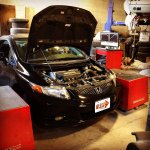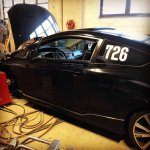Yeah the seat is all the way back anyway cause I'm a really tall guy. Not to mention that the twinlead is completely out of the way of the rails of the seats. That is if you are talking about the front seats.
The rear seats have a hinge and the wire is completely out of the way of that too, I routed it on the drivers side instead of the passengers side, because the passengers side is quite busy, its got 35mmSQ cable running through it through where the fabric of the seat and back rest meet, I just routed the wires up through there and it works a treat.
Everything is fine.
I did not know that you wax a car before winter comes but now that you mention it it makes sense because then you can scrape the snow off without damaging the paintwork.
If I were there I would be wrapping the whole car, that way I no longer need to wax.
The rear seats have a hinge and the wire is completely out of the way of that too, I routed it on the drivers side instead of the passengers side, because the passengers side is quite busy, its got 35mmSQ cable running through it through where the fabric of the seat and back rest meet, I just routed the wires up through there and it works a treat.
Everything is fine.
I did not know that you wax a car before winter comes but now that you mention it it makes sense because then you can scrape the snow off without damaging the paintwork.
If I were there I would be wrapping the whole car, that way I no longer need to wax.
Last edited:
Speaking of starter batteries, my Supercharge Gold Plus starter battery is officially dead, after 5 years.
I guess those years of using it as a cyclic battery with a solar panel didn't do it any good. It done well considering the circumstances.
I'm really considering using something else now besides lead acid batteries. I'm just done with them entirely.
I guess those years of using it as a cyclic battery with a solar panel didn't do it any good. It done well considering the circumstances.
I'm really considering using something else now besides lead acid batteries. I'm just done with them entirely.
Brand New.Super Capacitors Set.16.2v 500f Maxwell. Weld Type. | eBay
This sounds like a nice project.
This sounds like a nice project.
Just finished my car winterization yesterday. Corvette with new battery esconced in garage. Fusion with new oil, filter, ATF, air filter, safety recall complete, winter tires. Flex with 4 new pads, rear rotors, and winter tires. Only stupid mistake was tires on backwards, since I followed recommended X pattern for tire rotation on AWD, and then on the 4th tire realized they were directional tread, which trumps everything. Something to remember for next year.
Maybe some people don't wear their sides differently. I know I do. I haven't decided whether it's my local roads or just me.
I'm pretty sure that's universal. Cars are asymmetric and rarely drive with balanced passenger weight. My tires and brake parts always wear differently from side to side.
I'm pretty sure that's universal.
My open dif RWD Ford Mustang always ate the right rear tire first......I wonder why?
Both of the Hondas we now have do a pretty good job of wearing both sides at the same rate. I always swap front to back without swapping sides since I only have one floor jack and am lazy. The Pilot is 4WD, and quite heavy so it should wear evenly from side to side, and does.
Why my Element does, I don't know since it will spin the left front tire on a left turn in a traction limited situation. Right front rarely spins, but my typical drive sees more right turns than lefts. It's 11 years old and I drive it gently since I plan to keep it as long as it behaves. It did see about 10K miles pulling a heavy trailer through the mountains early in it's life, which may have caused some excessive transmission wear, but so far shows no signs.
I have had it 10 years, changed the battery three times, the tires twice, replaced both power window regulators, and all 4 brake pads once. I change the oil when the dashboard reminder tells me to, using only Mobil 1.
No other maintenance has been done, except for a few trips to the Honda store for serious recalls, like exploding air bags, and air in the braking system due to a faulty seal.
I can't think of what kind of vehicle I could replace it with. I am the only driver, I very rarely carry a passenger, both rear seats have been removed since I carry mostly stuff, it gets over 20 MPG around town and cost me $15K to buy (one year old used car) and maybe $2K to maintain over 10 years.
I have noticed that some cars will wear brake pads unevenly since the design of the calipers allows for that most of the time. The fixed calipers won’t do that nearly as much compared to those with sliders.
I like the Honda Element, having grown up with VW busses, I quickly identified with the open interior and functional rubber flooring.
I like the Honda Element, having grown up with VW busses, I quickly identified with the open interior and functional rubber flooring.
We used to have a 1975 VW van with about a 4'x4' rubber mat and plastic seat covers.
My mom would really park the van sideways on a sloped driveway, pull the mat out and hose it down along with the rest of the back of the van. I has three brothers and being able to hose it out was essential.
My mom would really park the van sideways on a sloped driveway, pull the mat out and hose it down along with the rest of the back of the van. I has three brothers and being able to hose it out was essential.
That’s a nice looking BMW.
Spent Saturday afternoon/evening getting my civic tuned. I’ve opened up the air intake and the exhaust. The horsepower at the wheels went from 167 to 198. A nice improvement. We were at 190 hp at 7100 rpm. A bit more tuning a well as upping the rev limiter to 7300 rpm got the last little bit. Can’t wait for the next track day to really try it out.
Spent Saturday afternoon/evening getting my civic tuned. I’ve opened up the air intake and the exhaust. The horsepower at the wheels went from 167 to 198. A nice improvement. We were at 190 hp at 7100 rpm. A bit more tuning a well as upping the rev limiter to 7300 rpm got the last little bit. Can’t wait for the next track day to really try it out.
Attachments
Link to Instagram with a video clip
Evan Cotler on Instagram: “#dynotune #civicsi #hondapower#apituning #apituned @apituning”
Evan Cotler on Instagram: “#dynotune #civicsi #hondapower#apituning #apituned @apituning”
That’s pretty respectable for no internal modifications. The best I have seen from another 2azfe Toyota engine was 190,but that was after head work, no tuning.
There is an oil additive I have used, gives a 3% gain in power, consistently, I have found.
I have used it on and off for 25 years or more. Is called PowerUp, maybe you’ve heard of it.
The nature of the product may lend itself to keeping your motor alive longer with the hard cornering also.
Have you looked at modifying an oil pan with baffles, doors?
There is an oil additive I have used, gives a 3% gain in power, consistently, I have found.
I have used it on and off for 25 years or more. Is called PowerUp, maybe you’ve heard of it.
The nature of the product may lend itself to keeping your motor alive longer with the hard cornering also.
Have you looked at modifying an oil pan with baffles, doors?
Thanks. I was quite happy with the result. The car being fairly light and having a ridiculous final drive rati (4.76/1) feels fairly quick.
Baffling the oil pan on this motor is involved requiring new oil pump and timing chain. More then I want to do. I did install a two quart oil accumulator that buys me some time when the oil pickup is uncovered.
I haven’t used any oil additives but do use synthetic oil. The car calls for 0w20. I’ll look at the additive you suggest
E
Baffling the oil pan on this motor is involved requiring new oil pump and timing chain. More then I want to do. I did install a two quart oil accumulator that buys me some time when the oil pickup is uncovered.
I haven’t used any oil additives but do use synthetic oil. The car calls for 0w20. I’ll look at the additive you suggest
E
Also, the 0W-XX oils are an edict from the government somehow, intended to save fuel by having less viscosity, lower parasitic drag, etc.
However, it’s not really effective, and saves just a negligible amount, a tiny percentage that is almost not measurable.
So if you feel the need to use a different oil, like say, 5W-40, like Mercedes and some others use, there isn’t anything that would prevent you from doing so.
I don’t like to get into oils too much, is like religion with cars it seems and most already have a preference, so sorry to belabor that one. And lube failures are pretty rare also
However, it’s not really effective, and saves just a negligible amount, a tiny percentage that is almost not measurable.
So if you feel the need to use a different oil, like say, 5W-40, like Mercedes and some others use, there isn’t anything that would prevent you from doing so.
I don’t like to get into oils too much, is like religion with cars it seems and most already have a preference, so sorry to belabor that one. And lube failures are pretty rare also
0W-XX oils are an edict from the government somehow......saves just a negligible amount, a tiny percentage
Back in the late 80's and early 90's I raced the FWD Dodge 2.2 L turbo cars. I discussed modifications and bought some expensive parts from Carroll Shelby who was affiliated with Chrysler at the time. After blowing up transaxle number 3 or 4 I called him. He asked what I was running in it for lube, and I told him that I used the ATF that was recommended in the owners manual.....that's when he explained CAFE.
Corporate Average Fuel Economy is a standard mandated by the US government dictating a number that every car manufacturer must make averaged across it's entire lineup, weighted by number of each vehicle sold.
As Carroll spelled out, Dodge must sell a lot of gas sipping 4 cylinder cars to make up for each Viper that they sell. Boosting the MPG number even a little bit on all those Dodge Omni's can allow for a Viper to suck gas at the less than 10 MPG rate, and it dictates how many Vipers that they can sell. Sooooooo....
In order to boost the MPG rating on my Turbo Dodge, they tell you to run some thin motor oil, and run ATF in the manual transaxle. This gets them 1/4 to 1/2 an MPG out of the car without too big a ding in their warranty claims, but sucks to the guy that stuck 200+ HP of boosted turbo motor in place of the 84 HP wheezer.....
Mr. Shelby then told me to run Mobil 1 engine oil in the 5 speed manual, and add just a little bit of "Slick 50" a Teflon additive that was popular then. Too much Slick 50 stuff would mess up the syncros and make the car hard to shift. I don't remember the viscosity for the Mobil 1 but it was thinner than what I was running in the engine. This reduced friction in the gearset, which took some stress off of the transaxle case. Case flex was what was causing my bearing failure. Slam shifting second gear at 7200 RPM wasn't helping too much either, but that's what it took to beat the 5.0 Mustangs on the dragstrip.
Since beating the turbo cars HARD for nearly 10 years on the road and track without a single turbo (common in Chryslers) or other engine failure, I have put Mobil 1 in every car since. I put 10W30 in my Honda Element. It also has just over 100K and 10 to 15 K of those were hard earned miles pulling 2000 pounds of trailer through the mountains.
The other day I was braking over a speed hump which I approached at a fast walking pace when the ABS kicked in momentarily on the down side. I figured I needed to reduce the rebound damping to re-plant the tyre after a compression stroke, so I took it back a notch. I blamed the changing weather for the upset.What is "Infinitely variable damping" in context of a shock absorber? Is it just marketing talk for a valve that controls fluid flow from the secondary expansion chamber to the main chamber in a twin tube shock absorber?
Later, at normal speeds I noticed the front was bobbing. Rebound was overshooting and the suspension resonance was showing. This is annoying as it is unrelated to the road surface and is more of a transient response. Disturb it, and the suspension will do its own thing for a while. So I returned to my previous setting (which I had spent some time on before) and the feel went flat again.
Clearly the problem is that sometimes you can't have both. Some suspension has separate damping controls for high speed and low speed disturbances and otherwise tries to close this gap.
- Home
- Member Areas
- The Lounge
- The car thread


